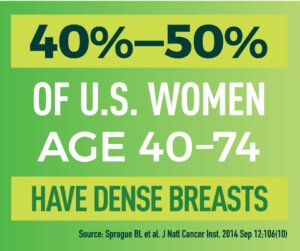
The automated breast screening ultrasound is the latest technology that women with dense breasts should have.
Perhaps the biggest advantage to this technology is that it pretty much eliminates operator error.
I recently underwent a breast screening ultrasound using an automated instrument. I’m glad I had this done because the technician told me that it greatly reduces operator error.
What an Automated Breast Ultrasound Feels Like: Setting Up the Compression
I lied on the examination bed, and the right breast was done first. A pillow was wedged under my right side.
My right arm was raised behind my head, similar to how you do this for a self-exam.
I was instructed not to talk during the scanning.
The technician smeared a lot of gel on my breast, then moved the instrument over it. I had my eyes closed, so all I perceived at this point was what this automated ultrasound felt like.
The device was placed on top of my breast, and I could tell that it was contacting mainly the left side.
She told me that she was going to compress it. I felt the pad contour to my breast as it pressed down. She stopped and asked if I felt okay and I said yes.
She said she was going to compress it more, and to let her know if the compression got too uncomfortable.
It started feeling like a mammogram, except that the entire left side of the breast was feeling compressed from a point above, rather than being squeezed around the nipple as in a mammogram.
She asked if I could tolerate one more added level of compression and I okay’d it. It felt pretty tight, but tolerable.
The Actual Scanning
This is where it got uncomfortable, but this also depends on how sensitive your nipples are. I felt a rolling sensation up and down my breast, and every time it rolled over the nipple, I just reminded myself that this was necessary and it had to be done.
But the rolling over the nipple was definitely the most uncomfortable aspect. I just patiently waited it out, lying still, knowing that it would be over very soon.
The technician did not move the scanner. It seemed to be just sitting there atop my breast as it did its job.
When it was done she lifted the mechanism, smeared on more gel, then repositioned the instrument over the right side of my breast.
I knew I’d have to bear that rolling-pin-like feeling over my nipple again.
She then did the other side, and interestingly, the compression wasn’t as much, and thus, the rolling over the nipple didn’t feel as uncomfortable.
I pointed out that the compression was lighter. She said that sometimes it just feels that way, and what’s important is to get a good fit over the breast.
After the procedure my breasts were slightly sore, but nothing distracting. But I could tell that I’d just had a procedure done on them.
The automated breast ultrasound compresses the nipple and rolls over the nipple – multiple times.
This is the biggest difference in how it feels when compared to a mammogram, which does not compress the nipple.
Women with dense breasts should get screening ultrasounds every year.
 Lorra Garrick has been covering medical, fitness and cybersecurity topics for many years, having written thousands of articles for print magazines and websites, including as a ghostwriter. She’s also a former ACE-certified personal trainer.
Lorra Garrick has been covering medical, fitness and cybersecurity topics for many years, having written thousands of articles for print magazines and websites, including as a ghostwriter. She’s also a former ACE-certified personal trainer.
.









































